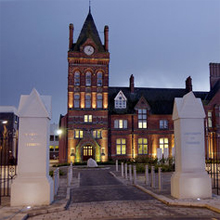 |
| FIREscape features addressable, self-contained LED luminaires connected via low voltage cabling |
Teesside University has become firmly established as one of the UK’s foremost higher education establishments. Located in Middlesbrough, on the south bank of the River Tees, it began life as a technical college designed to support the region’s engineering, bridge and shipbuilding industries.
Officially opened by the future King Edward VIII on 2nd July 1930, it was then known as Constantine College after the local shipping magnate, Joseph Constantine, who contributed £80,000 to its construction. In 1969 it was renamed Teesside Polytechnic, and in 1992 the Privy Council gave approval to 14 higher education institutions, including Teesside, to become universities.
Currently home to nearly 29,000 students, Teesside University has won praise for its dynamic, energetic and innovative approach. It is one of only five UK universities to be accredited with Investors in People Gold status in recognition of the staff engagement displayed in delivering its vision, values and strategy. It also achieves consistently high rankings in surveys that assess the quality of education on offer, and in 2009 it was named as the Times Higher Education (THE) Awards University of the Year.
Over the last few years, Teesside University has made a £135m investment in improving its facilities. Middlesbrough Tower is the most eye-catching structure on the campus and at 11 storeys high it houses the main reception area, administrative facilities and teaching areas.
As one of the oldest buildings on the site, it is currently undergoing a phased refurbishment. The building’s previous emergency lighting system had been in place since the late 1960s and for the University’s estates manager, David Newton, it was time to upgrade this important part of its life safety infrastructure.
Newton explains, “The central battery systems had become expensive to run and maintain, and took up quite a lot of space because they were backed up with a series of uninterruptible power supplies (UPS). Also, the 80W luminaires that the old system used needed to be changed on an all too frequent basis, and this took a lot of time and money to do. Therefore, I wanted to install a system that would reduce overheads, while utilising the latest energy saving technology.”
Teesside University has had a long-standing relationship with local life safety specialist, Tees Fire Systems. The company designs, supplies, installs, commissions and repairs fire detection and emergency lighting systems all over the UK and has gained an enviable reputation for its expertise.
Tony Cooney is the company’s technical sales director, and comments, “David had very specific criteria for the new emergency lighting system and we had to suggest a solution that could meet all of them. We have worked with Hochiki Europe for many years and have always been highly impressed with the design, quality and reliability of its products. Having heard about the newFIREscape emergency lighting solution, which utilises light emitting diode (LED) technology, we believed it would be ideal for this particular application.”
“I was very impressed with the entire installation process and it also gave me a chance to assess FIREscape in-situ. Needless to say, it surpassed all my initial expectations" |
Manufactured in the UK, FIREscape is an EN 50172 compliant intelligent low voltage system, which comprises an addressable emergency lighting control panel with battery back-up, and features addressable, self-contained LED luminaires and signage connected via low voltage (40V) cabling. The luminaires are also equipped with battery back-up, ensuring they will function in every situation.
Cooney asked Mark Smith, Hochiki Europe’s UK sales manager, to visit the site. Smith comments, “When I met Tony and David, as well as talking to them about the many features of the system, I was also able to provide an accurate idea of the long-term cost savings it could offer.”
Hochiki Europe recently carried out a comparison of FIREscape compared to a traditional manual test system and identified all the costs associated with each on a 1,000 luminaire system used over a 10 year period. Smith adds, “It factored in maintenance labour, battery replacement, testing labour, recycling costs, energy use and initial capital outlay. We found that over this period of time FIREscape could save a massive £184,885, with a CO2 reduction of over 29.5 tonnes.”
Such is the sheer size and scope of the project that the emergency lighting system is being fitted in a series of planned phases. The first phase was successfully completed in late 2011 and David Newton says, “I was very impressed with the entire installation process and it also gave me a chance to assess FIREscape in-situ. Needless to say, it surpassed all my initial expectations and I had no hesitation in giving the go-ahead for its installation across the rest of the estate.”
Four years on from when it first started, five floors of Middlesbrough Tower have been completed, while work has also started in the nearby Constantine Building. So far, over 500 LED luminaires and have been sited and these are linked to four addressable control panels using existing cabling. Once the project is completed the control panels will be networked so that they can be monitored from a central location with the estates department.
The system has been configured with two modes that are programmed via the control panels. The first is an emergency mode, where the lights operate at maximum illumination if there is a power failure. Secondly, normal or maintained mode means that the system can be used as part of the permanent lighting of the building during pre-defined periods of a day. This is currently employed in the main corridors and stairs for when the cleaners are carrying out their work in the building.
"Not only is it incredibly energy efficient and easy to maintain, it has provided us with an emergency lighting solution that significantly enhances the safety of staff and students alike” |
Asked about the installation process itself, Tony Cooney replies, “The luminaires fit directly on to a standard Hochiki Europe sensor base. The whole process can be completed very quickly and this means that we cause minimum disruption to the operation of the building during normal working hours.”
Due to its complexity, maintaining the previous system was a major problem and involved significant time, effort and money. However, with FIREscape, the estates management team can maintain it in-house and remain compliant with EN 50172, due to its use of low voltage cabling. The control panels continuously monitor and test the functionality of the system and it can also be pre-programmed to carry out specific monthly, six monthly and annual tests.
This level of in-built functionality also makes the system fully compliant with the requirements of BS 5266-1:2005, while reducing Teesside University’s operational overheads. What’s more, its long life LED technology also means that it requires only one per cent of the bulb changes required with traditional lighting, lowering costs even further.
The final word goes to David Newton, who concludes, “We were one of the first organisations to install FIREscape and it's a decision that I’m extremely pleased about. Not only is it incredibly energy efficient and easy to maintain, it has provided us with an emergency lighting solution that significantly enhances the safety of staff and students alike.”
Tees fire systems also provide a full service for all life safety systems such as disabled refuge, nurse call, access control, emergency call systems, and emergency lighting.




